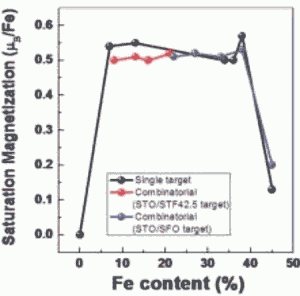Multifunctional Magnetic Oxides
- Category: Materials
- Tags: caroline ross, nicholas aimon
Perovskite oxides can have a range of electronic, optical, and magnetic properties that make them valuable in devices. In this project we explore the room temperature ferromagnetism induced in SrTiO3 (STO) thin films by substituting the B-site Ti with transition metals (Cr, Mn, Fe, Co, and Ni) during growth by pulsed laser deposition on various substrates. In the SrTi1-xFexO3 (STF) and the SrTi1-xCoxO3 (STC) systems with less than about 50% Fe or Co, the materials show ferromagnetism up to 1000 K with ~0.5 – 1 µB per magnetic ion and a strong out-of-plane anisotropy, which is attributed to magnetoelastic effects [1] because the films are strained by epitaxial growth on the substrates. Above 50% substituent, the magnetic moment decreases (Figure 1). The magnetism of these materials is reduced if the films are grown in oxygen, compared to vacuum, so is associated with the presence of oxygen vacancies and mixed valence Fe or Co. We are investigating these effects with density functional theory simulations. High throughput study of a wider range of systems involving other transition metals (Mn, Cr, Ni) was demonstrated using combinatorial pulsed laser deposition (CPLD), which allows the deposition of thin films with a spatially varying concentration of the substituent [2] . The perovskite films were grown on Si using buffers of CeO2/YSZ, enabling integration on a Si platform. We demonstrated self-assembly of STF grown on buffered Si, in which strain relaxation and surface charge minimization drive the formation of (110) nanopillars in an (100) matrix. Further understanding of these materials may facilitate their incorporation into nonvolatile logic or memory or in nonreciprocal optical devices.
Multifunctionality can be tailored by assembling materials with distinct properties in a single composite material. Bottom-up approaches such as self-assembly are very desirable because of their low cost and usually high throughput. We grew dual phase materials by codeposition, including composites of perovskites and spinel phases. BiFeO3/CoFe2O4 (BFO/CFO) two-phase perovskite-spinel nanocomposites were grown by self-assembly using CPLD, resulting in ferrimagnetic CFO pillars embedded in a ferroelectric BFO matrix (Figure 2). Epitaxial strain in the highly magnetoelastic CFO phase dramatically influences the magnetic anisotropy of the films [3] . It is also possible to induce strain in the magnetoelastic phase by ferroelectrically straining the matrix with an applied voltage, making these nanocomposites very attractive for applications requiring a strong magnetoelectric coupling, such as magnetic logic and memory devices.
- Figure 1: Magnetic moment of SrTi1-xFexO3 samples with different Fe content grown at high vacuum from stoichiometric targets and from two end-member targets using a combinatorial method.
- Figure 2: Free-standing CFO pillars after selective etching of the BFO matrix from a CPLD-grown nanocomposite CFO/BFO thin film.
- D. H. Kim, L. Bi, P. Jiang, G. F. Dionne, and C. A., Ross, (2011) “Magnetoelastic effects in SrTi_{1−x}M_{x}O_{3} (M = Fe, Co, or Cr) epitaxial thin films,” Physical Review B, vol. 84, no. 1, pp. 1-9. [↩]
- D. H. Kim, L. Bi, N. M. Aimon, P. Jiang, G. F. Dionne, and C. A. Ross, (2012). “Combinatorial pulsed laser deposition of Fe, Cr, Mn and Ni- substituted SrTiO3 films on Si substrates,” ACS Combinatorial Science, vol. 14, no. 3, pp. 179-90. [↩]
- N. M. Aimon, D. H. Kim, H. K. Choi, and C. A. Ross, (2012)“Deposition of epitaxial BiFeO3/CoFe2O4 nanocomposites on (001) SrTiO3 by combinatorial pulsed laser deposition,” Applied Physics Letters, vol. 100, no. 9, pp. 092901. [↩]

